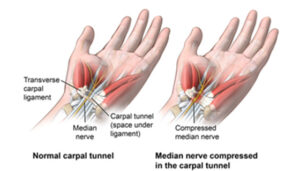Carpal Tunnel Syndrome
The wrist is a complex area with many bones and ligaments. These provide strength, stability and support for the hand and wrist. Specifically, they protect the median nerve that supplies feeling and movement to your thumb, index finger, middle finger and part of your ring finger.
When a nerve is compressed, it can cause problems with function and sensation. These symptoms can include pain, numbness and tingling in your hands or wrist. In the hand, the median nerve passes through a narrow space called the carpal tunnel. This tunnel is surrounded by the bones of your wrist (underneath) and a strong ligament called the transverse carpal ligament.

If any of these areas become swollen or inflamed, it can put pressure on the median nerve and cause Carpal Tunnel Syndrome Explained. Your doctor will use a variety of tests to determine if you have carpal tunnel syndrome. These tests will help your doctor identify the cause of your problem and recommend treatment options.
Carpal Tunnel Syndrome Explained
Physical examination: Your doctor will take a detailed history and do a thorough physical exam of your hand. The exam may include a range of motion exercises to test how well your fingers and wrist move. Your doctor also may do a few X-rays to see if there are any problems with your wrist bone.
Imaging: X-rays and MRI scans are used to look at the inside of your wrist. These images can show if there are changes in the bone, or if there are any other abnormalities that may be causing the problem. Ultrasound: An ultrasound can be used to view the carpal tunnel and examine the bones, tendons and nerves that run through it. This can help your doctor determine if there is any inflammation or mass in the carpal tunnel.
Electromyography and Nerve Conduction Studies: These studies can help your doctor assess how well your median nerve works, which may be important to identifying the cause of your symptoms. Splinting and Anti-Inflammatory Medicine: Wearing a wrist splint at night can keep your wrist from moving, which eases compression of the nerves in the carpal tunnel. You can also take nonsteroidal anti-inflammatory drugs, such as ibuprofen, to reduce swelling.
Exercises: Occupational and physical therapists can teach you exercises that can be done at home to stretch and strengthen your fingers, wrist and hand. These exercises can help relax your muscles and tendons and stretch the ligaments that hold the tendons in place.
Other options: If splinting and medications don’t help, steroid injections into your carpal tunnel can relieve pain. These injections are most effective when they are done on a regular basis. Surgery: In the most severe cases, your doctor can cut the ligament atop the carpal tunnel to make it bigger and to reduce pressure on your median nerve. This is known as open release surgery or carpal tunnel release surgery.
These surgeries have been shown to cure many people of their carpal tunnel syndrome and have a good track record of long-term results. However, they can be more expensive and require a longer recovery time than non-surgical methods.



